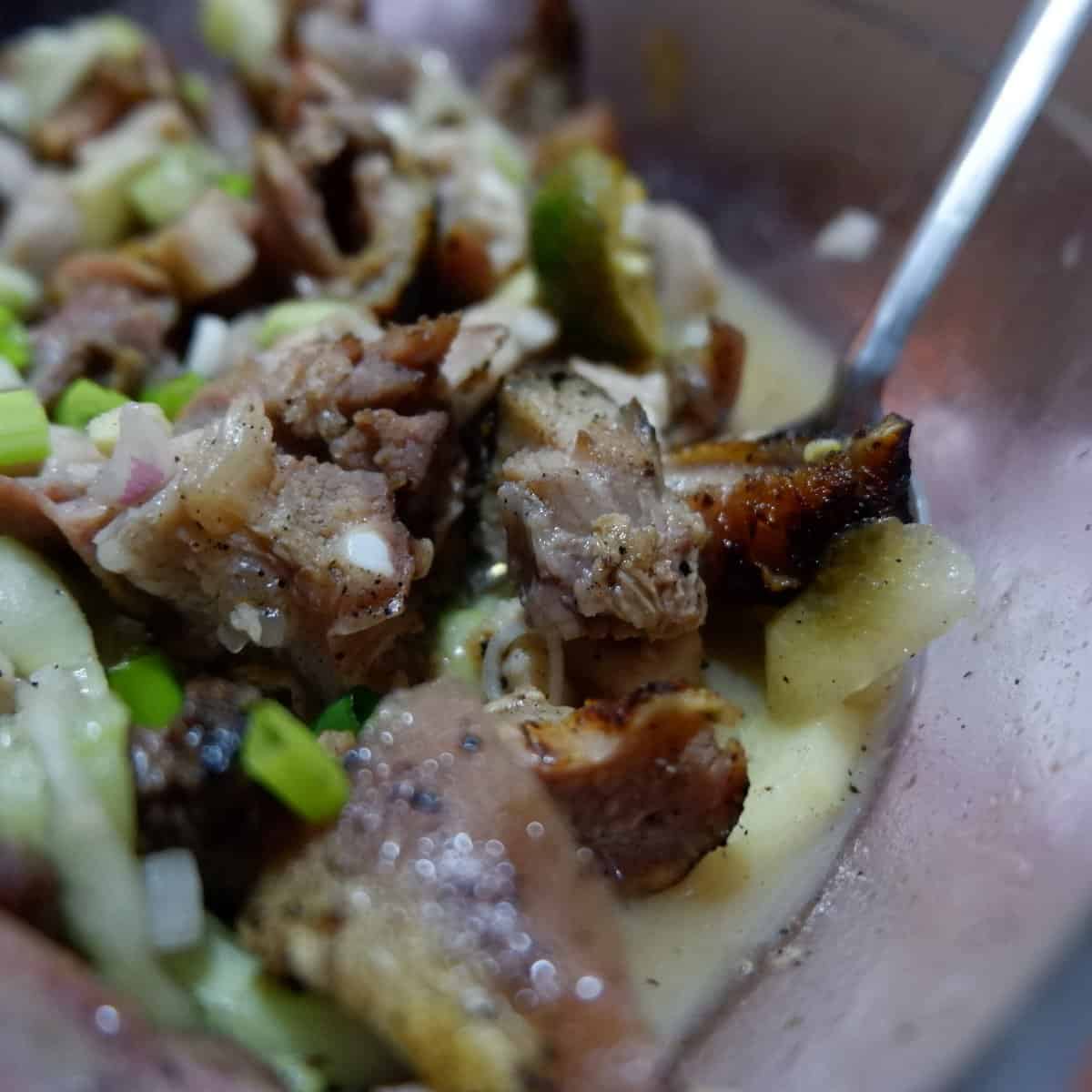Sinuglaw: The history and How it’s Served
Sinuglaw is basically a marriage of 2 different recipes; namely, sinugba and kinilaw. The name of the recipe also comes from the aforementioned names!
The “sinug” in “sinuglaw” refers to “sinugba”, which is literally “to grill” in the Visayan language. And the “law” coming from “kinilaw” means “cooked raw with vinegar”.
This means the sinuglaw recipe also borrows the cooking process and ingredients of the aforementioned dishes, with grilled pork belly from sinugba, and cured fish, chili peppers, and onions from kinilaw.
Simple but savory, this dish is an explosion of flavors. You have a tangy and spicy taste from the kinilaw and you have the hearty and sweet flavors of the liempo estofado.


Check out our new cookbook
Bitemybun's family recipes with complete meal planner and recipe guide.
Try it out for free with Kindle Unlimited:
Read for freeIn this post we'll cover:
Origin
Since the dish is made by combining 2 different dishes, there’s not much information available as far as the dish’s own history is concerned. However, It’s completely safe to say that the recipe is strictly Filipino since both sinugba and kinilaw originate from the Visayas and Mindanao areas of the country.
How to Enjoy Sinuglaw: A Guide to Serving and Eating
Sinuglaw (full recipe here) is a unique dish that combines the flavors of grilled pork and fresh fish in one delicious recipe. To prepare this dish, you’ll need the following ingredients:
- 1/2 lb. grilled pork, sliced into small pieces
- 1/2 lb. fresh fish, sliced into small pieces
- 1/4 cup soy sauce
- 1/4 cup vinegar
- 1/4 cup calamansi juice (or lemon juice)
- 1 small red onion, chopped
- 1 small ginger, sliced into thin strips
- 1-2 red chili peppers, chopped (depending on how spicy you want it)
Mixing the Ingredients
Once you have all the ingredients ready, it’s time to mix them together to create the perfect sinuglaw dish. Here’s how to do it:
- In a bowl, mix together the soy sauce, vinegar, and calamansi juice to create the sauce.
- Add the chopped red onion, sliced ginger, and chopped chili peppers to the sauce and mix well.
- Add the sliced grilled pork and fresh fish to the sauce mixture and mix well.
- Let the dish marinate for at least 30 minutes to allow the flavors to fully develop.
Things to Keep in Mind
While sinuglaw is a super delicious dish, there are a few things to keep in mind when preparing and serving it:
- Be careful when handling the internal organs of the fish, as they can be quite delicate and easily break apart.
- If you’re a vegetarian, you can still enjoy sinuglaw by substituting the meat with tofu or other vegetarian protein sources.
- Experiment with different forms of fish and meat to find the perfect combination for your taste buds.
- Overall, the goal is to create a dish that is both spicy and tangy, with the perfect balance of sweet and sour flavors.
In short, sinuglaw is a special dish that requires a little bit of preparation and a lot of love. But the end result is definitely worth the effort, as it is a great way to experience the unique flavors and power of Filipino food.
Is Sinuglaw Good for You?
Sinuglaw is a famous dish in the Visayas and Mindanao regions of the Philippines. It is composed of two types of seafood, sinugba (grilled) and kinilaw (soaked in citric acid), mixed together in one bowl. The dish is easy to prepare, and the marriage of the two opposite cooking methods creates a delicious appetizer or main course.
Types of Seafood Used
Sinuglaw is typically made with fresh white fish, such as snapper, and pork belly. The fish is prepared as kinilaw, while the pork belly is cooked as sinugba. The two are then combined in a bowl and gently mixed together.
Health Benefits
Despite being a delicious dish, is sinuglaw healthy? The answer is yes! Here are some reasons why:
- The dish is composed of fresh seafood, which is a great source of protein and omega-3 fatty acids.
- The citric acid in the kinilaw helps prevent the growth of bacteria in the fish.
- The pork belly used in sinugba is ground and cooked, which helps reduce the fat content.
- The dish is typically served with fresh vegetables, such as onions and chillies, which provide additional nutrients.
Preparation
Preparing sinuglaw is simple and easy. Here’s how:
- Grill the pork belly until cooked and slightly charred.
- Soak the fish in lemon or calamansi juice for a few minutes to create the kinilaw.
- Combine the two in a bowl and gently mix together.
- Serve with fresh vegetables and a cup of rice.
What’s the Difference Between Sinuglaw and Kilawin?
Sinuglaw and kilawin are two popular dishes in the Visayas and Mindanao regions of the Philippines. Both dishes are composed of fresh, raw ingredients and are served as mains or appetizers in restaurants and homes. However, there are some key differences between the two dishes:
- Sinuglaw is a marriage of two dishes: sinugba (grilled pork belly) and kinilaw (raw fish marinated in vinegar or citric juice). Kilawin, on the other hand, is a dish made solely of raw fish or meat marinated in vinegar or citric juice.
- Sinuglaw is a solid dish, with chunks of grilled pork belly and raw fish mixed together in a red or white mixture. Kilawin is a more liquid dish, with the meat or fish thinly sliced and marinated in a tangy sauce.
- Sinuglaw is considered heartier and more filling than kilawin, thanks to the addition of the fatty pork belly. Kilawin, on the other hand, is a more balanced dish, with the addition of additional vegetables and spices to prevent the dish from going too dark or spicy.
How to Prepare Sinuglaw and Kilawin
Preparing sinuglaw and kilawin is relatively easy, but there are some key differences in the preparation of each dish:
- To prepare sinuglaw, start by grilling a large piece of pork belly until it is cooked through and slightly charred. Remove any excess fat and chop the meat into small pieces. In a separate bowl, mix together chopped raw tuna or other fish, diced tomatoes, onions, and cane vinegar. Gently pour the mixture over the pork belly and serve.
- To prepare kilawin, start by choosing a high-quality fish or meat. Tuna is a popular choice for kilawin, but other types of fish or even bacon can be used. Thinly slice the meat or fish and set it aside. In a separate bowl, mix together cane vinegar, chopped onions, and ground black pepper. Gently pour the mixture over the meat or fish and let it marinate for at least 30 minutes before serving.
Which is the Best: Sinuglaw or Kilawin?
Both sinuglaw and kilawin are delicious dishes that are popular throughout the Visayas and Mindanao regions of the Philippines. The word “sinuglaw” itself is a combination of the words “sinugba” and “kinilaw,” meaning that the dish is a fine example of the marriage of two different types of food. Kilawin, on the other hand, is a simple yet delicious dish that is ideal for those who want to enjoy the fresh, raw flavors of fish or meat.
Ultimately, whether you prefer sinuglaw or kilawin depends on your personal taste preferences. If you’re looking for a heartier, more filling dish, sinuglaw is the way to go. If you want something lighter and more balanced, kilawin is the better choice. Either way, both dishes are worth trying if you want to experience the best of Visayan and Mindanaoan cuisine.
Conclusion
So there you have it- everything you need to know about Sinuglaw. It’s a delicious Filipino dish that you can easily prepare at home with just a little bit of effort.
Now that you know the secret to making Sinuglaw, you can enjoy it as a meal or an appetizer with some rice.
Check out our new cookbook
Bitemybun's family recipes with complete meal planner and recipe guide.
Try it out for free with Kindle Unlimited:
Read for freeJoost Nusselder, the founder of Bite My Bun is a content marketer, dad and loves trying out new food with Japanese food at the heart of his passion, and together with his team he's been creating in-depth blog articles since 2016 to help loyal readers with recipes and cooking tips.

